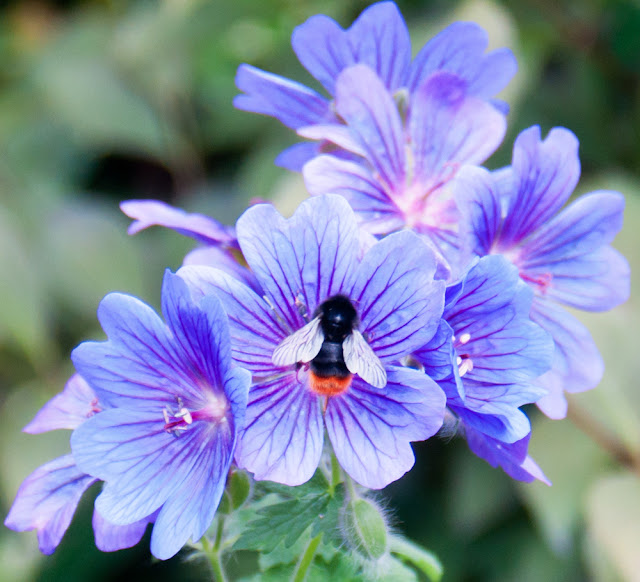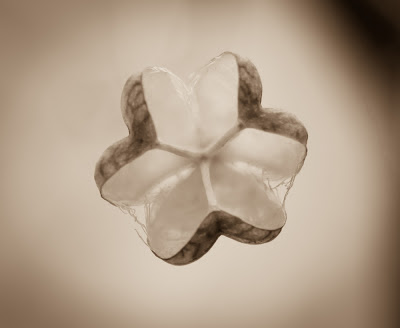30 June 2013
Summer Panorama
Garden65 in all its summery glory.
And here it is in its wintery baldness:
Proof that the sun does, sometimes, shine on Manchester.
29 June 2013
Catch Up 6: Gratuitous Hoverflies
Last catch up. Hurrah!!
I like hoverflies.
Hold on, let my qualify that statement. I definitely don't like them buzzing around my head. But I do admire their neatness.
I don't know what the shrub is though. Suggestions welcome.
Catch Up 5: Bees
I think this little lady is a Tree Bumblebee (Bombus hypnorum) which is a new species that arrived in the UK in 2001, but we aren't to worry because it is not affecting native bees.
 |
| Distribution of tree bumblees. Green spot shows first sighting in 2001. |
This bee is (and don't quote me, but I think it is a fair bet) a red-tailed bumble bee (Bombus lapidarius).
And this last is bit of a mystery. It may be a cuckoo bumble bee.
As their name suggests they lay their eggs in other bees nests.
The site Plantsforbumblebees explains:
In the UK there are 6 species of cuckoo bumblebees . These were once like other bumblebees, but they have switched to a parasitic existence. The females kill or evict the queen and take over her workers as their own, using them to rear their own offspring. If you live in the south of England, males of the southern cuckoo bumblebee can be among the most common bumblebees in July and August.Cuckoo bees hang around outside the nest of the bees they are imitating in order to acquire their scent and make it easier for them to get in without a fight. Cuckoo bees only produce queens or males, hence their need to take over a nest and have the workers tend to their needs. However, if the host bee is rare then so is the cuckoo bee for that species. Cuckoo bees have no pollen baskets - they don't need them. They have fewer hairs on their legs, more chitin on their bodies and a longer sting.If we look at our bee in close up I'd say that is a hairless leg with no pollen basket, and a big sting. Cuckoo bumblebee it is then.
Catch Up 4: Colour Wheel : Blues and Yellows
If you looked at the current bloomings of Garden65 you would think they were the result of careful plant selection.
What with yellow day lilies contrasting with blue geraniums (and hated creeping buttercup) ...
And fiery 'fox and cubs' cosying up to the electric blue of ceanothus.
Of course you would be completely wrong - Mother Nature is the painter.
 |
| Geothe's colour wheel showing blues and purples as complementary colours to yellow and orange |
Catch Up 3: Seed Pod Quiz
The first of the seed pods have matured and popped.
Incredible isn't it? It looks like the head of a dinosaur. Look at those sharp teeth in that strong jaw.
What plant do you think spawned this monster?
Surprisingly, it's of the elegantly delicate fritillary.
Mind you, it does have a reptilian look about it.
Catch Up 2: Mistaken Identity
When I made a guest appearance at my mum's gardening group I came away with some attractive stripey sticks.
At the time the planters by the decking were empty, after the pathetic black bamboo had been wrenched out, so since the sticks looked like bamboo I shoved them in. For months they remained inert, but now they are beginning to bud.
Which is good of course.
However, some active Googling reveals they are not bamboo but horsetails (Equisetum japonicum), they of the 'weeds you don't want in your garden' variety. Marvellous.
To be honest, and less dramatic, they are not the weedy horsetail but a more cultivated type which should really be planted in a pond.
Their days are numbered, one way or another.
Catch Up 1: Cheap Plants
I have been remiss for not writing as often as I should, but that is not to say the fleshly Garden65 has been neglected. This year's pottering seems to have paid off and now a sea of lushness laps at the backdoor.
I have been (oh dear, 'the passive voice'. But not sure what the remedy is so I'll carry on heedlessly ['heedlessly carry on'?] ) taking photos to show you this gorgeousness but they've remained unseen on the flashcard until this afternoon. So here comes a wave of observations ...
No. 1:
The other night I caught lovely Monty rounding off a Gardener's World programme with advice about buying plants. He held aloft a pot containing a huge spray of nodding leaves and told us to buy the most expensive plant we could afford. This would most likely be a healthy plant that would quickly settle down into its new home and romp away to give us years of pleasure. If you were extra lucky it may also be splittable, providing you with two plants for the price of one. Sound advice.
With Monty's silken words echoing in my mind I visited our nearest, somewhat dissolute, garden centre with £20 to spare and a gap of about 3 square metres to fill.
Unfortunately the plants that came nearest to Monty's luxuriant standards were between £8 and £12. Doing the maths this meant I couldn't afford the planting scheme (yes, I did have one) I had envisioned.
Saddened I began to trudge back to the car, and then caught sight of the poor bedraggled herb section (as opposed to the healthy herb section). These were around £1.59 to £1.99 each. Result!
I am trying to nurture a mini Piet Oudolf patch, which I wrote about last November, and I think these tall swishy herbs like fennel will give the same effect. I'm not sure how they will look in the winter, and I'm concerned about the final size of the two artichokes, but I'm happy enough. Of course, as Monty predicted there was only one struggling plant per pot, and they don't seem to have got over the shock of being planted yet, but we have to live within our means, don't we?
16 June 2013
Tiger Tiger
Madam is back
She stalks her jungle
a dark mysterious place peopled with ancient statues of forgotten gods
and luminous fairy flowers
Inscrutable
Indifferent
As impenetrable as her terrain
11 June 2013
10 June 2013
My Compost Heap Frightens Me
At the end of the garden lurks an oozing, pulsing heap of darkness.
I try to ignore it. I smile at the innocent little daisies on the lawn, admire the pretty ladybirds, glory in the swifts overhead and am grateful for the beauty all around. But the horrible truth cannot be denied: Decay resides in a far corner. Busy Decay at that.
Edgar Allan Poe missed a trick by not making a compost heap the menacing centre of a short story. Like the portrait in the attic, or the maddening beat of a heart, the compost bin sits, doom laden, forever warning of the end that awaits us all.
I suppose you've got to get to grips with this reality if you are a gardener - a thoughtful, ecologically aware, bit of a depressive kind of gardener anyway. The cycle of life and all that. You put dead plants in, let an Hieronymus Bosch horde of creatures eat it up, then eventually get life-giving compost out at the end. Grim.

A Yellow Slug, Limax flavus (Lt flavus = yellow)
White-lipped Snail, Cepaea hortensis (Lt hortensis = garden)
4 June 2013
Hopes Dashed
Good grief, the sun is out.
And ladybirds are trundling about.
I had high hopes this white-faced specimen was a native. She was small with relatively simple markings and seemed to be bumbling around the edge of the parsley pot like a humble peasant.
I guessed she may be a native 10 spot.
But alas, no.
Offered up to I Spot 'Grizzledbadger' identified her as a non-native Harlequin. Which immediately turns her into a gaudy trollop.
Grizzledbadger backs up his arguement with this observation:
Stylised M on pronotum,a H.axyridis f. succinea variant where the spots only occur on the front/ pronotum end of the elytra.Mr Badger thus gives us an opportunity to learn some new interesting words:
Subscribe to:
Comments (Atom)










































